Environmental Pollution ( IF 7.6 ) Pub Date : 2019-12-16 , DOI: 10.1016/j.envpol.2019.113815 Lien K Ngo 1 , Helen L Price 2 , William W Bennett 3 , Peter R Teasdale 4 , Dianne F Jolley 5

|
Increasing soil contamination of arsenic (As) and antimony (Sb) is posing a serious concern to human health. Due to insufficient studies on Sb, the biogeochemical behaviour and plant uptake of Sb are assumed to be similar to that of As. As part of extensive research unravelling As and Sb biogeochemistry and plant uptake, the diffusive gradients in thin films (DGT) technique and sequential extraction procedure (SEP) were applied to evaluate As and Sb uptake by the white icicle radish (Raphanus sativus) cultivated in diluted cattle dip soils contaminated with As only and diluted mining soils contaminated with both As and Sb under agricultural conditions. Labile As and Sb in these soils measured by DGT (CDGT), soil solution (Csol), and SEP (CSEP-labile), were compared with As and Sb bioaccumulation in R. sativus tissues. Regardless of contamination sources and measurement techniques, the results showed that As was consistently more labile than Sb although total As concentrations in two soil types were lower than total Sb. Labile As in cattle dip soils was higher than that in mining soils, although there were no significant differences in soil As concentrations. The analysis of R. sativus tissues revealed that the overall As bioaccumulation was 4.5-fold higher than for Sb, and that As translocation to shoots was limited. In contrast, considerable Sb translocation to shoots was observed. The As and Sb bioaccumulation were strongly correlated with their CSEP-labile, CDGT, and Csol (R2 = 0.87–0.99), demonstrating the effectiveness of these techniques in predicting As and Sb in the white icicle radish. Compared with the cherry bell radish previously studied, the white icicle radish exhibited higher bioaccumulation factors (BAF) for Sb, but lower BAF for As, and lower translocation of As and Sb to shoots, providing understanding of how As and Sb are accumulated by radish cultivars.
中文翻译:

DGT和选择性提取揭示了白色冰柱萝卜(Raphanus sativus)吸收砷和锑的差异。
土壤中砷(As)和锑(Sb)的污染日益严重,已严重危害人类健康。由于对Sb的研究不足,因此认为Sb的生物地球化学行为和植物吸收与As相似。作为揭示As和Sb生物地球化学和植物吸收的广泛研究的一部分,应用薄膜中的扩散梯度(DGT)技术和顺序萃取程序(SEP)评估了栽培于土壤中的白冰萝卜(Raphanus sativus)对As和Sb的吸收。在农业条件下,仅由砷污染的稀牛浸土和由砷和锑污染的稀矿土。通过DGT(C DGT),土壤溶液(C sol)和SEP(C将SEP不稳定(SEP不稳定)与Sa.ustivus组织中的As和Sb生物蓄积进行了比较。不论污染源和测量技术如何,结果都表明,尽管两种土壤类型中的总砷浓度均低于总锑,但砷始终比锑更不稳定。尽管土壤砷的浓度没有显着差异,但牛浸土中的不稳定As高于采矿土壤。番茄组织的分析表明,总砷的生物累积量比锑高4.5倍,而且砷向芽的转运受到限制。相反,观察到大量的Sb易位到芽。砷和锑的生物蓄积与其不稳定的C SEP,C DGT密切相关,和C sol(R 2 = 0.87–0.99),证明了这些技术在预测白色冰柱萝卜中的As和Sb方面的有效性。与先前研究的樱桃铃萝卜相比,白色冰柱萝卜的Sb具有更高的生物累积因子(BAF),但As的BAF较低,As和Sb向芽的转运降低,从而使人们了解了萝卜如何积累As和Sb。品种。


















































 京公网安备 11010802027423号
京公网安备 11010802027423号